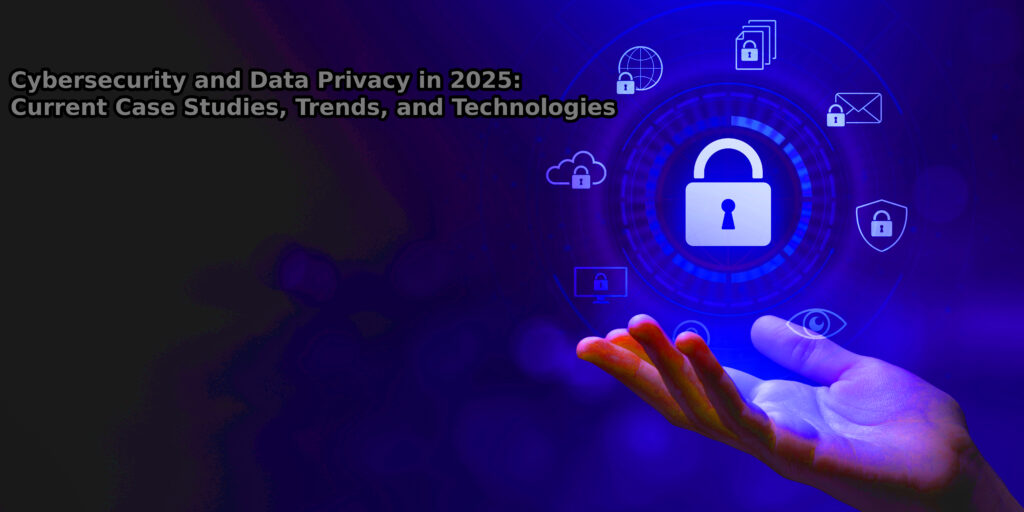Explore the top cybersecurity and data privacy trends of 2025. Learn about Zero Trust architecture, AI threat detection, global regulations, and cutting-edge technologies keeping digital systems secure. cybersecurity and data privacy. From high-profile ransomware attacks to legal battles over personal data, the need for secure, ethical digital practices is more pressing than ever. This article explores the key trends, case studies, and technologies shaping the world of cybersecurity and data privacy in 2025.
Table of Contents
Part 1: Emerging Trends in Cybersecurity and Data Privacy
1. Zero Trust Architecture (ZTA)
What it is: A framework where no user or device is trusted by default — even if it’s within the network perimeter.
Case Study:
- Google’s BeyondCorp model has been widely adopted across enterprises, allowing secure access without relying on VPNs.
- The U.S. Department of Defense has implemented a full Zero Trust framework to protect critical infrastructure from both internal and external threats.

2. AI and Machine Learning for Threat Detection
What it is: Leveraging artificial intelligence to detect and respond to threats in real-time.
Examples:
- Companies like Darktrace and CrowdStrike use behavioral analysis powered by machine learning to identify anomalies.
- IBM Watson for Cybersecurity now assists in incident response by automatically recommending mitigation steps.
3. Post-Quantum Cryptography&Cybersecurity and Data Privacy
Why it’s important: Quantum computers could break today’s encryption standards.
Ongoing Research:
- NIST is leading the global race to finalize quantum-resistant algorithms.
- Banks and government institutions are beginning to implement hybrid cryptographic systems.
4. Ransomware as a Service (RaaS)
What it is: Cybercrime groups offering ransomware tools to less tech-savvy criminals.
Recent Attacks:
- Colonial Pipeline Attack (2021) set the stage, but 2025 has seen REvil’s resurgence, using AI-enhanced encryption.
- Case studies from CISA (Cybersecurity & Infrastructure Security Agency) show how businesses that invested in cyber hygiene and backups recovered faster.
5. Biometric Authentication & Spoofing Challenges
Current Focus:
- Deepfake detection is now a priority, especially in facial recognition systems.
- Fingerprint and iris scan spoofing are under study by major companies like Apple, Samsung, and Synaptics.
Part 2: Global Legal and Compliance Landscape
6. GDPR & Global Data Regulations
Europe’s GDPR remains the gold standard, but 2025 has seen:
- India’s DPDP Act (Digital Personal Data Protection)
- California’s CPRA
- China’s PIPL
These laws are driving companies to:
- Implement data minimization techniques.
- Use Privacy Enhancing Technologies (PETs).
7. Landmark Legal Cases
- Meta vs. Ireland’s DPC: Meta was fined over $1.2 billion for violating data transfer laws.
- Clearview AI vs. Canada: Highlighted the dangers of unregulated facial recognition databases.
- TikTok’s global scrutiny: Ongoing probes over data being shared with foreign governments.
Part 3: Tools, Technologies, and Frameworks
8. Next-Gen Firewalls & EDR Solutions
- SentinelOne, Microsoft Defender, and Palo Alto Networks offer real-time endpoint detection and response (EDR).
- Cloud-native firewalls are becoming essential for SaaS and hybrid cloud platforms.
9. Cloud Security & Shared Responsibility
Case Study:
- Capital One Data Breach (2019) led to better understanding of cloud misconfiguration risks.
- In 2025, businesses now adopt multi-cloud compliance checkers and Cloud Security Posture Management (CSPM) tools.
10. Privacy Enhancing Technologies (PETs)
Technologies like:
- Homomorphic encryption (used by Microsoft and IBM).
- Differential privacy (Apple & Google for user analytics).
- Federated learning (used in health data training without sharing actual data).
Part 4: Sectors Most Affected in 2025
Healthcar
- IoMT (Internet of Medical Things) has made patient care more efficient, but data breaches in hospitals have risen.
- Hospitals use blockchain for tamper-proof health records.
Enterprise IT
- Increased adoption of SIEM (Security Information and Event Management) tools.
- Focus on insider threats and behavioral analytics.
Education
- Universities use identity verification tools for online exams.
- Case: University of California breach via phishing on outdated software.
Smart Homes
- IoT vulnerabilities in smart cameras, voice assistants, and home routers.
- Legislation is evolving to enforce manufacturers to provide basic security standards (e.g., default password bans).
